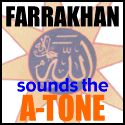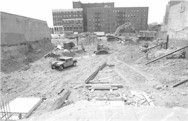|
|
|
NEW YORK�Laura Evans was born and raised in Harlem and now owns her own boutique, L.F. Knitwear. The 50-something year-old native New Yorker was able to get into business with help from an Empowerment Zone loan guarantee. It wasn�t easy but she got funding three years ago. Still she is haunted by a worrisome question. "With all that I have accomplished my greatest fear is that my son who has a good job will not be able to purchase a brownstone here in the community where he has grown up," Ms. Evans admits. She fears that the empowerment zone that helped her get money will bring other changes that aren�t so good�high income new residents, changes in the cost of living, more expensive housing and an influx of whites. She isn�t the only one with such fears.
With empowerment zone incentives, closeness to downtown Manhattan�s business and financial districts, and easy access to other boroughs and businesses just across the George Washington Bridge in New Jersey, Harlem is a very attractive place to live. Crime is also down 77 percent since 1995, according to NYPD. However, since 1994 when the UMEZ opened its doors on the corner of 125th Street and Lenox Avenue, many in Harlem have feared the community known as the "Mecca of Black Culture" could turn white. Bill Landers, whose job is to help small businesses get UMEZ loans and help from local banks, argues things have been put in place to help the little people. Terry C. Lane, the new UMEZ president, echoed the same feelings. "No one has been here to lend the money to the small business person until now. That is why the UMEZ was brought in�to bring capital. People want better goods and services," he said. But not everyone is biting. William Minic has run his cabinet making shop on East 117th Street for 22 years. He does not understand why the state wants to condemn 12 nearby properties, ending the careers of 114 skilled laborers, 20 whom are employed in his factory. If city plans are approved, he may have to close his business, and be replaced by a national hardware chain and a major food and appliance warehouse store. "Eminent domain is supposed to be used for the public good. What this is about is giving a developer land for dirt cheap because now they think Harlem is safe for their (white) people. It�s what we used to call a land grab," said Mr. Minic. Upper Manhattan is a 7.2 mile stretch of land with the Harlem and Hudson Rivers at its east and west boundaries. The empowerment zone starts at 96th Street and ends at 222nd Street. There are 520,000 residents who have more than $6 billion in purchasing power. According to the UMEZ, over 70 percent of local residents shop outside of the community due to lack of quality goods and services. Harlem is 84 percent Black, 13.6 percent Latino and 2.4 percent white, according to the latest Census figures. Median income is $25,000-$30,000 a year, but some residents earn much more, while others earn much less. "When you talk about Harlem you are talking about one of the most complex urban environments in the world," said Lionel McIntyre, associate professor for urban planning at Columbia University. He was one of the early architects of a major plan to overhaul Harlem in the 1980s. At that time, the key was supposed to be funding for small business, he noted. The current plan focuses mainly on attracting large businesses and doesn�t do enough for small businesses, he complains. "People in Harlem see the construction crews moving from street to street. They are seeing lots long abandoned by their owners being cleaned and prepared for development and there is seemingly no one who has the time to explain what is the purpose of all of this activity," said Professor McIntyre, during a phone interview with The Final Call. Mr. McIntyre believes programs for Harlem�s poor, like welfare, are gone and the poor will soon be driven out. "The vacant housing that is being developed for $2,000 a month rent is not being developed for those who depend on the social welfare safety net, such as Section 8. People are almost voluntarily saying, �I�m getting out of here.� " "We know that people are concerned about gentrification," said Karen Phillips, president and CEO of the Abyssinian Development Corporation, which is a product of the historic Abyssinian Baptist Church once pastored by Adam Clayton Powell, Sr., whose son was the legendary congressman from Harlem. She is part of a joint effort to lock Black people into a positive future in the community. The Abyssinian Development Corporation, the Black United Fund, and Harlem Congregations For Community Improvement have joined together to form a housing partnership which created 12,000 units of affordable housing. The partnership has a membership of some 90 churches. Most of the units, which were limited to people with $35,000 to $70,000 annual incomes, have been sold. The Abysinnian Development Corporation is working on rehabbing another 33 buildings and the partnership is looking to keep rehabbing buildings to ensure affordable places to live. The partnership wants to acquire condemned buildings and create middle-income cooperative apartments. The first 36-unit condo cooperative, Striver�s Gardens, has been approved and groundbreaking should take place next spring. But an example of the scramble for land in Harlem can be found in a recent decision by the city to offer nine lots, already earmarked for housing, to for-profit and non-profit developers. The city, over the next four months, will examine 45 proposals from 23 developers, and sell the lots for $1 apiece. The proposals range from plans for middle-income housing to condos that would sell for more than $240,000 each. Poppy�s clothing store is located some 150 feet from the famed Apollo Theater on 125th Street. Its owner told The Final Call, "We are going backwards. Congressmen Powell picketed some stores to get Blacks jobs and today we have far too many stores on this street that our people patronize�and they still don�t hire Black workers." He also asks why major stores like Old Navy, Disney and The Gap are courted, while his business languishes. "Tell me why the epowerment zone money went to them and people like me couldn�t get a dime? Tell me why the Apollo is now in the hands of Time Warner, a white-owned company?" he adds. "Harlem needs sound business investments," said Rodney Lopez, a former UMEZ public relations person. "We are creating an environment for the big tax realtors with our loan guarantees. There needs to be a balance. There is 15 percent unemployment up here and our goal is to develop some 12,000 jobs by year 2004. We are investing in people as well as the overall business community," he said. "The white community is not going to empower Black people," counters Kermit Eady, executive director of the Black United Fund. "We cannot make policy without power. Jobs and empowerment are not synonymous. We do not own these big stores," he said. Mr. Eady believes greater unity and a common agenda could help Harlemites and alleviate some of the fear. "If we are to continue to talk about economic development there needs to be an economic summit, where we establish an agenda," Mr. Eady said. "Where are the politicians?" he asked. "All of this development comes out of the demand from our community, from our people, that something must be done," said Harlem Councilman Bill Perkins, who argues the UMEZ is good and that grassroots activists backed by political leaders like himself will protect Black interests. Councilman Perkins sees a future community with more working families, senior citizens, a few more whites and affluent Blacks. "We have a fear when we see white folks, a legitimate paranoia that we are going to be displaced, but I see a new Harlem. Black people will not have to flee Harlem. Brothers and sisters are returning to do battle," said Councilman Perkins. Perhaps one real problem has been the size of the empowerment zone and many groups and individuals trying to do a lot of things at the same time. There also appears to be too little explanation about what is going on. The one thing that many community leaders agree on is that there has been too much focus on 125th Street, a major shopping and tourist area, which boasts the Apollo Theater, Harlem State Office Building and Harlem USA, which is a shopping and entertainment complex. "We must strengthen busi-nesses on the other avenues. Improving those streets makes the neighborhoods much nicer," said Ms. Phillips. The Abyssinian Development Corporation is now negotiating with a group of Black doctors who are interested in opening an International House of Pancakes and the Black United Fund has started by developing businesses beyond 135th Street. Photo: Construction began on Harlem USA, in the Harlem neighborhood of New York at the intersection of West 125th St. and Frederick Douglass Boulevard July 1998. The 275,000 square foot retail and entertainment complex is scheduled for occupancy by December 1999. |

 The Upper Manhattan Empowerment Zone (UMEZ) is a federal initiative
which provided $100 million in development funds and $250 million in
business tax credits to rebuild Harlem. Empowerment zones are supposed
to bring progress to impoverished communities. Gov. George Pataki and
Mayor Rudolph Guiliani have provided matching funds of $100 million each
and have placed representatives on the empowerment zone governing board.
The Upper Manhattan Empowerment Zone (UMEZ) is a federal initiative
which provided $100 million in development funds and $250 million in
business tax credits to rebuild Harlem. Empowerment zones are supposed
to bring progress to impoverished communities. Gov. George Pataki and
Mayor Rudolph Guiliani have provided matching funds of $100 million each
and have placed representatives on the empowerment zone governing board.